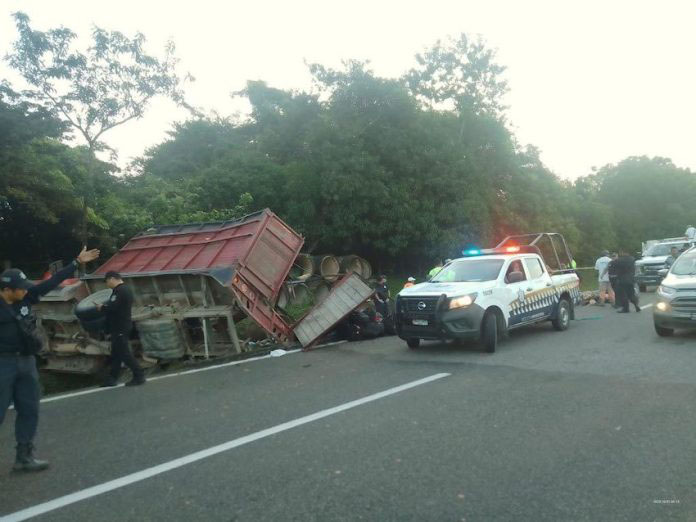by the El Reportero‘s wire services
Ten Cuban migrants died and 17 more were injured when an overloaded truck overturned in Chiapas early Sunday morning.
The accident happened on the Pijijiapan-Tonalá highway, which is frequently used by migrants traveling north from the Guatemalan border towards the United States. The dead were all women, one of them a minor.
According to a statement by Mexico’s National Migration Institute (INM), “the driver was speeding, lost control of the unit and overturned.” The driver then fled.
Photos of the accident scene show that the truck was a wooden-backed Ford model not designed to carry people, and was also missing license plates. The vehicle was almost entirely destroyed on impact.
Of the 27 Cuban migrants traveling in the truck, 17 survived but were seriously injured. They were transferred to hospitals in Pijijiapan and Huixtla for treatment, and Cuban authorities are being kept informed of their condition.
The newspaper El Universal reported that the migrants had spent several days in Tapachula trying to obtain Mexican humanitarian visas before boarding the truck north. The human smugglers who facilitated the journey have not been identified by authorities.
With reports from CNN, Reuters and El Universal
Bolivia and Brazil will talk about a binational bridge
La Paz, Sep 27 (Prensa Latina) The Minister of Public Works, Edgar Montaño, assured that today Bolivia and Brazil will hold a technical meeting about the construction of the Guayamerín-Guajara Mirín binational bridge, which will link the department of Beni with that country.

“Once again we ratify all our predisposition to make this bridge a reality, that is why this Wednesday we will hold a technical meeting with Brazil and the next day (Thursday) an informative meeting will be held on the conclusions,” Montaño wrote in his X account (previously Twitter).
Benjamín Blanco, Vice Minister of Foreign Trade and Integration, for his part, stated that the purpose of the meeting is to define the necessary specifications for the construction of the bridge, which will connect the regions of Guayaramerín, Bolivia, and Guajará Mirín, in Brazil.
The Governments of both countries are in the process of exchanging technical information, after the Brazilian side sent a proposal with the request for Bolivian observations already sent, in accordance with the corresponding procedures for this type of works.
The bidding process must be approved by the Brazilian-Bolivian Mixed Commission, which will be convened after the approval of the technical project, and the territorial authorities of Beni and the municipality of Guayamerín will also be invited to that meeting, as reported.
The road over the Mamoré River dates back more than a century, however, despite the fact that there was a commitment to its execution, former president Jair Bolsonaro shelved the project.
The proposal was reactivated by presidents Luis Arce and Luiz Inácio Lula da Silva.
This is a historic debt established in the Treaty of Petrópolis, of 1903, which provides for a 1,200-meter bridge at a cost of 52 million dollars, covered by Brazil, a counterpart that guarantees up to 70 million for this purpose, according to Blanco.
For his part, the governor of Beni, representing the opposition Third System Movement party, Alejandro Unzueta, demanded that the Government not truncate the construction of the binational project and that the report proposed by the Bolivian Ministry of Public Works be withdrawn.
The residents of Guayamerín, meanwhile, announced an ultimatum to the Government to make the work viable and threatened to carry out blockades throughout the department.
However, Blanco confirmed that “we have been able to see, on the part of the Government of Brazil, all the predisposition to reach mutually beneficial agreements for the construction of this bridge, to be able to shorten the times as much as possible (…) and have a bridge that satisfies the needs, both of our population of Beni and of the Brazilian part.”



